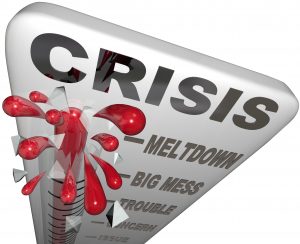
The PR crisis for your company has already begun, so what should you do? Part 1: Simplify and Clarify Your Message.
Ready Fire Aim. That’s how too many companies handle a crisis. They respond before they know what their message is, and they end up saying the wrong thing to the wrong audience.
It’s easier if you plan for a crisis in advance so you can execute your strategy when needed, but a lot of companies find themselves unprepared during an emergency. For this four-part blog series, let’s focus on four topics of what to do after the crisis has already started.
Part 1: Simplify and Clarify Your Message
Part 2: Internal Communication (i.e. to staff, investors, etc.)
Part 3: Communicating with impacted customers and your supporters
Part 4: External Communications with reporters and the public
Let’s jump right in to Part 1, shall we?
When a crisis occurs, companies tend to make one of two opposite, but equally painful, mistakes.
One mistake is being too afraid to say anything at all, and by taking too long to respond the company fails to stop the bleeding before the damage is complete. A quick acknowledgment and action by the company is essential to ending a crisis. The more news cycles the company waits to show they care and are trying to fix the problem, the worse it will be.
The other mistake is speaking too quickly without an organized strategy or a designated spokesperson from whom all statements will be controlled and consistent. A company can look pretty bad when different spokespeople contradict one another. It only leads to more confusion and issues to resolve. It also looks horrible when a statement is made, but only hours or days later the company needs to backtrack because the company’s desired message or strategy has changed.
Both of these mistakes (and the inconsistencies they create) are not due to ineptitude by any individuals. Rather, it’s simply a lack of a simple message and simple direction from the top. In the middle of a media crisis, it’s too late to form a committee and discuss options. Leadership needs to act quickly to calm the storm, but clarity and consistency is also needed.
Simplify and Clarify Your Message
One of the first things company leaders need to quickly decide are a few core message points from which all statements and actions will revolve around – no matter who is speaking or listening. The key is clarity and direction. The statement should clearly and simply state what the company is focused on during the crisis, and what the company will do after the initial crisis is over.
For example, say your healthcare organization has a major HIPPA violation. An example of your core message points may be:
- We will take care of our patients impacted by the violation
- We will investigate and take action where appropriate
- We will redouble all efforts to prevent any future similar violation
These statements may not seem very deep, but they’re very powerful. They’re a promise allowing all parties, internal and external, to set their expectation. They become the mile markers for which the overall response can be judged.
The statement lets those who are impacted, the public in general, and the media know the company cares and is working on proper resolutions. It’s hard to hate someone that’s trying to help. It may not stop anger or fear, but there’s comfort in knowing the issue is not being ignored and the company has a plan of what to do to fix it.
To company spokespeople, it gives clear statements to convey to anyone that will listen. The statements are general enough that they can be given quickly to media, even before all the facts are known. It shows that the company isn’t ignoring the crisis, or the anger or fear it might create. It shows the company cares. It also creates a clear path to show the public in the future that the company followed through on its commitment, wherever that path might lead.
These simple but direct statements also give internal guidance to employees on how they are supposed proceed in the immediate aftermath of the crisis. It also points in the direction where the light at the tunnel will (eventually) appear.
The first statement, to take care of the patients effected, is something employees can start doing immediately. The second statement lets internal teams know they need to investigate what happened and the third statement instructs employees to figure out if anything needs to change internally to make sure such a violation doesn’t occur again.
Ultimately, during any crisis there’s lots of details and nuance that to insiders seem important. As company leaders, you need that info to evaluate the details and decide how to fix the problem, but these details aren’t important to the general public. From a message and direction standpoint, the best thing a company can do to protect its brand image and minimize the damage is to simplify and clarify the goals into a statement that is easy for everyone to understand and rally around.
– – written by Josh Weiss, President, 10 to 1 Public Relations